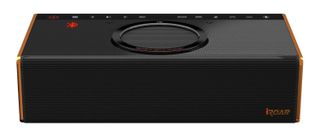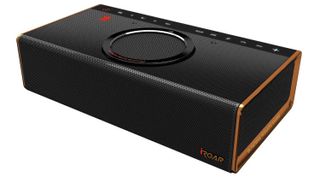Creative iRoar Speaker Review: Big Performance, Big Price
Creative's iRoar packs in almost everything you'd want from a Bluetooth speaker, except ruggedness, for a premium price.
Why you can trust Tom's Guide

Creative's Roar Bluetooth speaker overwhelmed us with features, and the new iRoar does even more — way more. From doubling as a soundbar to using apps to extend its functionality, the iRoar is made for people who want one speaker for many situations. Add in above-average sound, and the iRoar could be your go-to wireless speaker — if you can stomach the $370 price.
Design
With a conservative black-box design, the iRoar resembles the Roar, though it adds more elegant touches, such as bronze end caps. At 8.8 x 4.7 x 2.2 inches, it's a bit bigger than the 7.9 x 4.5 x 2.2-inch Roar, but much more compact than the 9.5 x 5.5 x 5.5-inch Marshall Kilburn. The sound is generated by two tweeters and a 2.75 woofer, and the unit adds passive radiators on the sides to improve the bass output.
Creative uses contextual controls on the top; the buttons you see depend on the mode you're in. If you tap the menu icon while listening to music over Bluetooth, it shows you forward, back and play/pause, as well as the option to answer calls. If you're playing from audio in, the phone button disappears.
The back of the unit features a cornucopia of connections: In addition to a connector for the power cord, there's a micro-USB port for an external audio source, a microSD slot for playback and storing apps, a 3.5-millimeter analog input, a digital audio optical input for connecting to a TV, and a USB output for charging mobile devices. And, of course, you can connect via Bluetooth.
The iRoar lacks any water resistance or other rugged features. Given everything else this speaker has, it's an odd omission that limits its usefulness outside the home.
MORE: Best Bluetooth Speakers for Home or On-the-Go
Features
What can't this speaker do? In addition to playing music and acting as a speakerphone, the iRoar doubles as a mini soundbar, thanks to its optical input. With a microSD card inserted, you can play audio directly from local storage; you can also record audio to the card.
The free iOS and Android apps beat what any other Bluetooth speaker offers and takes the options to another level. Like UE's apps for its Bluetooth speakers, you can select from sound presets such as BlasterX (boosted bass), Sonic Bass (more boosted bass) and Cinemania (bumps up the midrange and bass). You can also tweak all of these presets. But Creative is just getting started.
The free iOS and Android apps beat what any other Bluetooth speaker offers.
Through Voice Morph, you can actually change the way your voice sounds to the people you speak with on a call. You can choose from 18 voice modulations, including a child, a person with a deep voice or a demon. You'll have to decide whether this is crazy fun or just plain creepy.
You can save apps to the microSD card to give it even more features. Options include an alarm, a timer, nature sounds, a guitar tuner and more strange voices.
Performance
Beyond all the things it can do, the iRoar delivers very good sound, with impressive bass and midrange.
The iRoar performed best on pop and rock music. On "Can't Stop the Feeling!" Justin Timberlake's vocals came across clearly above the deep rumble of the bass. The driving bass on the Weeknd's "False Alarm" thumped deeply, while the vocals sounded full. The keys on Tame Impala's "Beverly Laurel" shimmered above the pop of the snare drum without getting lost.

However, the iRoar lacked the crisp treble that the Kilburn delivered, which was most apparent on acoustic songs. Big Star's "Thirteen" had rich bass and full vocals, but the picked guitar wasn't as crisp as it sounded on the Kilburn. The iRoar also struggled with the mix on Norah Jones' "Tragedy," burying her vocals among the piano and bass.
As a soundbar, the iRoar boosted the dialogue on movies and TV, and gave effects a good rumble. It didn't create much of a surround sound experience, but if you're mostly interested in a speaker for music and just occasional use with a TV, you'll be happy to find that it's an improvement over your TV speakers.
MORE: Our Favorite Outdoor (Waterproof) Speakers
The iRoar creates big sound for a small speaker. I measured a max of 92 decibels, but it felt louder than that. That's almost as loud as the larger Kilburn, which I measured at 94 decibels, and the UE Megaboom, which topped out at 95 dB. In addition to sheer volume, the iRoar pushes sound out widely, and can easily fill a large room with audio.
Wireless and Setup
The iRoar didn't have any trouble pairing to iOS and Android devices. Creative put a ring on top of the unit to help you target where to place an NFC-equipped mobile device for fast pairing — much better than trying to guess where the right spot is.

The unit is compatible only with Bluetooth 3.0, though, which is a step behind many current Bluetooth speakers, and I noticed issues with staying connected indoors when I moved more than 20 feet away. With a clear line of sight, it stayed connected out to about 30 feet.
In addition to the modes previously mentioned, you can activate Roar, which boosts the loudness and depth of sound, and Night Mode, which reduces loud bursts of sound, such as explosions, during movies. If you put in the effort to try out the different permutations, you should find a sound that pleases your ears.
Battery
Creative says you'll get 20 hours of use on a full charge, but that may be ambitious. After about 15 hours of playback, the battery was almost completely drained. I suspect that's because the unit didn't shut itself off even if I wasn't playing music.
You can also use the iRoar to charge other mobile devices via USB. With its 9,000-mAh capacity, you should be able to charge an iPhone 7 at least four times (if you're not using the iRoar's battery for playback).
MORE: Best Music Apps for Rocking Out
Bottom Line
The iRoar can do more than any Bluetooth speaker we've tried. The long list of features exceeds most people's needs, but you'll probably find a few that you enjoy, whether functional, like an alarm, or whimsical, like changing your voice. More important, the iRoar delivers big, full sound without taking up much space.
But at $370, it costs more than the $300 Marshall Kilburn, which delivers equal or better overall sound (depending on what you like to listen to), and UE's $300 Megaboom, which is rugged and very portable. If you just want to listen to music or have a speaker you can use by the pool or campfire, you can save a few dollars by choosing a different speaker. If you're likely to take advantage of all of the features the iRoar offers, though, the high price is well worth it.
Sign up to get the BEST of Tom’s Guide direct to your inbox.
Upgrade your life with a daily dose of the biggest tech news, lifestyle hacks and our curated analysis. Be the first to know about cutting-edge gadgets and the hottest deals.

Michael Gowan is a freelance technology journalist covering soundbars, TVs, and wireless speakers of all kinds of shapes and sizes for Tom’s Guide. He has written hundreds of product reviews, focusing on sound quality and value to help shoppers make informed buying decisions. Micheal has written about music and consumer technology for more than 25 years. His work has appeared in publications including CNN, Wired, Men’s Journal, PC World and Macworld. When Michael’s not reviewing speakers, he’s probably listening to one anyway.
